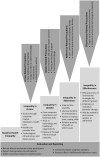Good intentions are not enough: how informatics interventions can worsen inequality
- PMID: 29788380
- PMCID: PMC7646885
- DOI: 10.1093/jamia/ocy052
Good intentions are not enough: how informatics interventions can worsen inequality
Abstract
Health informatics interventions are designed to help people avoid, recover from, or cope with disease and disability, or to improve the quality and safety of healthcare. Unfortunately, they pose a risk of producing intervention-generated inequalities (IGI) by disproportionately benefiting more advantaged people. In this perspective paper, we discuss characteristics of health-related interventions known to produce IGI, explain why health informatics interventions are particularly vulnerable to this phenomenon, and describe safeguards that can be implemented to improve health equity. We provide examples in which health informatics interventions produced inequality because they were more accessible to, heavily used by, adhered to, or effective for those from socioeconomically advantaged groups. We provide a brief outline of precautions that intervention developers and implementers can take to guard against creating or worsening inequality through health informatics. We conclude by discussing evaluation approaches that will ensure that IGIs are recognized and studied.
Figures
References
-
- Agency for Healthcare Research and Quality. National Healthcare Disparities Report 2009 (AHRQ 10-0004). Rockville, MD: US Dept of Health and Human Services; 2010.
-
- Kawachi I, Daniels N, Robinson DE.. Health disparities by race and class: why both matter. Health Aff (Millwood) 2005; 242: 343–52. - PubMed
-
- Ubri P, Artiga S.. Disparities in Health and Health Care: Five Key Questions and Answers. Washington, DC: Kaiser Family Foundation; 2016. http://www.kff.org/disparities-policy/issue-brief/disparities-in-health-... Accessed August 11, 2017.
-
- Phelan JC, Link BG, Tehranifar P.. Social conditions as fundamental causes of health inequalities: theory, evidence, and policy implications. J Health Soc Behav 2010; 51 Suppl: S28–40. - PubMed
-
- Phelan JC, Link BG.. Controlling disease and creating disparities: a fundamental cause perspective. J Gerontol B Psychol Sci Soc Sci 2005; 60 (Special_Issue_2): S27–33. - PubMed
MeSH terms
LinkOut - more resources
Full Text Sources
Other Literature Sources
Medical


